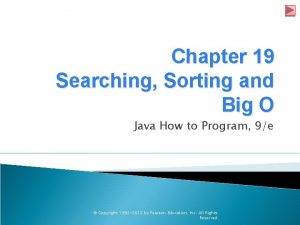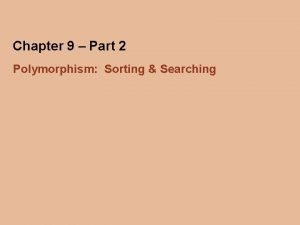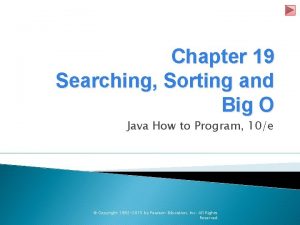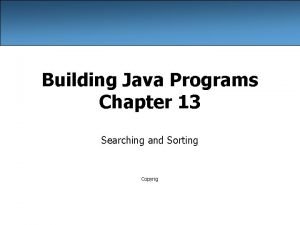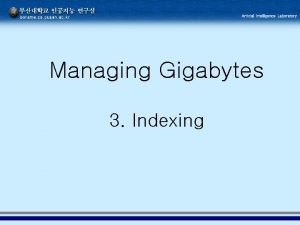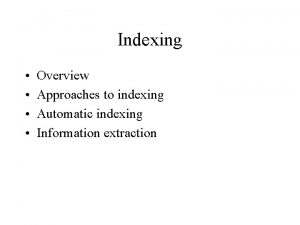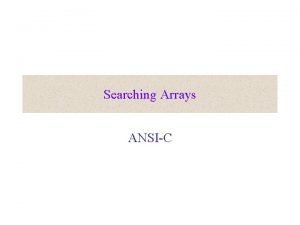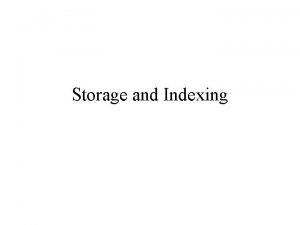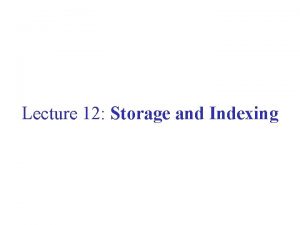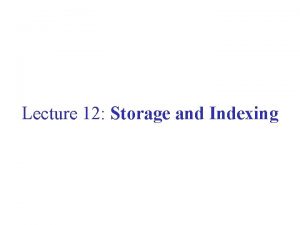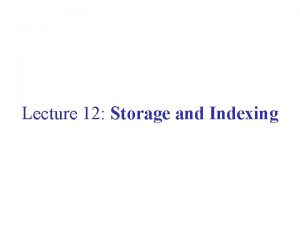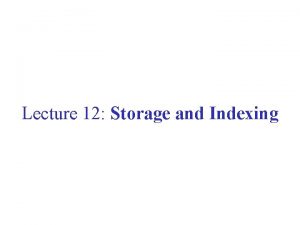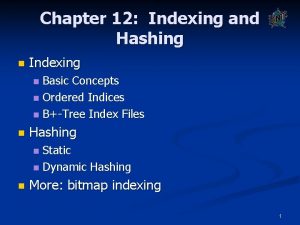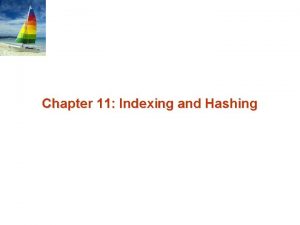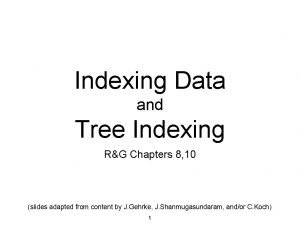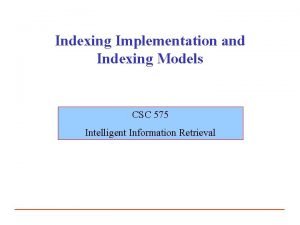Searching and Indexing Indexing is the initial part


















![ES_Query syntax { “fields”: [“name”, ”Id”] } ---------------------{ “from”: 0, “size”: 100, “fields”: [“name”, ES_Query syntax { “fields”: [“name”, ”Id”] } ---------------------{ “from”: 0, “size”: 100, “fields”: [“name”,](https://slidetodoc.com/presentation_image_h/371d2505338f9c6e287d0df2717e4662/image-19.jpg)
![ES_Query syntax { “fields”: [“name”, ”Id”] “query”: { } } ---------------------{“from”: 0, “size”: 100, ES_Query syntax { “fields”: [“name”, ”Id”] “query”: { } } ---------------------{“from”: 0, “size”: 100,](https://slidetodoc.com/presentation_image_h/371d2505338f9c6e287d0df2717e4662/image-20.jpg)
![Filter_syntax {“filter”: ”terms”: { “name”: [“ABC”, ”XYZ”] } -----------{ “filter”: { “range”: { “from”: Filter_syntax {“filter”: ”terms”: { “name”: [“ABC”, ”XYZ”] } -----------{ “filter”: { “range”: { “from”:](https://slidetodoc.com/presentation_image_h/371d2505338f9c6e287d0df2717e4662/image-21.jpg)
![Facets_Syntax { “facets”: { “facet_name”: { “terms”: { “name”: [”ABC”, ”XYZ”] } } Facets_Syntax { “facets”: { “facet_name”: { “terms”: { “name”: [”ABC”, ”XYZ”] } }](https://slidetodoc.com/presentation_image_h/371d2505338f9c6e287d0df2717e4662/image-22.jpg)


- Slides: 24

Searching and Indexing Ø Indexing is the initial part of all search applications. ØIts goal is to process the original data into a highly efficient cross-reference lookup in order to facilitate rapid searching. Ø The job is simple when the content is already textual in nature and its location is known.

Indexing • Steps: • acquiring the content. – This process gathers and scopes the content that needs to be indexed. • § build documents – The raw content that needs to be indexed has to be translated into the units (usually called documents) used by the search application. document analysis – The textual fields in a document cannot be indexed directly. Rather, the text has to be broken into a series of individual atomic elements called tokens. – This happens during the document analysis step. Each token corresponds roughly to a word in the language, and the analyzer determines how the textual fields in the document are divided into a series of tokens. • index the document – The final step is to index the document. During the indexing step, the document is added to the index.

Lucene • Lucene is a free, open source project implemented in Java. • licensed under Apache Software Foundation. • Lucene itself is a single JAR (Java Archive) file, less than 1 MB in size, and with no dependencies, and integrates into the simplest Java stand-alone console program as well as the most sophisticated enterprise application. • Rich and powerful full-text search library. • Lucene to provide full-text indexing across both database objects and documents in various formats (Microsoft Office documents, PDF, HTML, text, and so on). • supporting full-text search using Lucene requires two steps: • creating a lucence index – • creating a lucence index on the documents and/or database objects. Parsing looking up – parsing the user query and looking up the prebuilt index to answer the query.

Architecture

Query: not c: docseinstein. txt: String comparison slow! Solution: The important thing is not to stop questioning. Inverted index c: docsshakespeare. txt: To be or not to be. Advanced Indexing Techniques with Apache Lucene - Payloads

Inverted index be 1 important 0 is 0 not 0 1 or 1 questioning 0 stop 0 to 0 1 the 0 thing 0 Query: not c: docseinstein. txt: 0 The important thing is not to stop questioning. c: docsshakespeare. txt: To be or not to be. Document IDs Advanced Indexing Techniques with Apache Lucene - Payloads 1

Inverted index be 1 important 0 is 0 not 0 1 or 1 questioning 0 stop 0 to 0 1 the 0 thing 0 Query: ”not to” c: docseinstein. txt: 0 1 2 0 3 4 5 The important thing is not to stop questioning. 6 7 c: docsshakespeare. txt: 0 1 2 3 4 5 To be or not to be. Document IDs Advanced Indexing Techniques with Apache Lucene - Payloads 1

Inverted index be 1 1 5 important 0 1 is 0 3 not 0 4 1 or 1 2 questioning 0 7 stop 0 6 to 0 5 1 0 4 the 0 0 thing 0 2 Query: ”not to” c: docseinstein. txt: 0 1 2 0 3 4 5 The important thing is not to stop questioning. 6 7 c: docsshakespeare. txt: 0 1 2 3 4 5 To be or not to be. Document IDs Positions Advanced Indexing Techniques with Apache Lucene - Payloads 1

Inverted index with Payloads be 1 1 important 0 1 is 0 3 not 0 4 or 1 2 questioning 0 7 stop 0 6 to 0 5 the 0 0 thing 0 2 5 c: docseinstein. txt: 0 1 2 0 3 4 5 The important thing is not to stop questioning. 6 1 7 c: docsshakespeare. txt: 1 0 4 0 1 2 3 4 5 To be or not to be. Document IDs Positions Advanced Indexing Techniques with Apache Lucene - Payloads 1

Creating an Index (Index. Writer Class) § The first step in implementing full-text searching with Lucene is to build an index. §To create an index, the first thing that need to do is to create an Index. Writer object. §The Index. Writer object is used to create the index and to add new index entries (i. e. , Documents) to this index. You can create an Index. Writer as follows §Index. Writer index. Writer = new Index. Writer("index-directory", new Standard. Analyzer(), true);

Parsing the Documents (Analyzer Class) • The job of Analyzer is to "parse" each field of your data into indexable "tokens" or keywords. • Several types of analyzers are provided out of the box. Table 1 shows some of the more interesting ones. § Standard. Analyzer – A sophisticated general-purpose analyzer. § Whitespace. Analyzer §A very simple analyzer that just separates tokens using white space. § § Stop. Analyzer Removes common English words that are not usually useful for indexing. Snowball. Analyzer An interesting experimental analyzer that works on word roots (a search on rain should also return entries with raining, rained, and so on).

Adding a Document/object to Index (Document Class) • . To index an object, we use the Lucene Document class, to which we add the fields that you want indexed. • Document doc = new Document(); • doc. add(new Field("description", hotel. get. Description(), Field. Store. YES, Field. Index. TOKENIZED));

Elasticsearch (NO-SQL) What is Elastic. Search ? ● Open Source (No-sql DB) ● Distributed (cloud friendly) ● Highly-available ● Designed to speak JSON (JSON in, JSON out)

Highly available ● For each index you can specify: ● Number of shards – Each index has fixed number of shards ● Number of replicas – Each shard can have 0 -many replicas, can be changed dynamically


Admin API ● Indices – Status – CRUD operation – Mapping, Open/Close, Update settings – Flush, Refresh, Snapshot, Optimize ● Cluster – Health – State – Node Info and stats – Shutdown

Rich query API ● There is rich Query DSL for search, includes: ● Queries – Boolean, Term, Filtered, Match. All, . . . ● Filters – And/Or/Not, Boolean, Missing, Exists, . . . ● Sort -order: asc, order: desc ● Facets allows to provide aggregated data for the search request –Terms, Terms_stat, Statistical, ….

Scripting support ● There is a support for using scripting languages ● mvel (default) ● JS ● Groovy ● Python
![ESQuery syntax fields name Id from 0 size 100 fields name ES_Query syntax { “fields”: [“name”, ”Id”] } ---------------------{ “from”: 0, “size”: 100, “fields”: [“name”,](https://slidetodoc.com/presentation_image_h/371d2505338f9c6e287d0df2717e4662/image-19.jpg)
ES_Query syntax { “fields”: [“name”, ”Id”] } ---------------------{ “from”: 0, “size”: 100, “fields”: [“name”, ”Id”] }
![ESQuery syntax fields name Id query from 0 size 100 ES_Query syntax { “fields”: [“name”, ”Id”] “query”: { } } ---------------------{“from”: 0, “size”: 100,](https://slidetodoc.com/presentation_image_h/371d2505338f9c6e287d0df2717e4662/image-20.jpg)
ES_Query syntax { “fields”: [“name”, ”Id”] “query”: { } } ---------------------{“from”: 0, “size”: 100, “fields”: [“name”, ”Id”], “query”: { “filtered”: { “query”: { “match_all”: {} }, “filter”: { “terms”: { “name”: [“ABC”, ”XYZ”] } } }
![Filtersyntax filter terms name ABC XYZ filter range from Filter_syntax {“filter”: ”terms”: { “name”: [“ABC”, ”XYZ”] } -----------{ “filter”: { “range”: { “from”:](https://slidetodoc.com/presentation_image_h/371d2505338f9c6e287d0df2717e4662/image-21.jpg)
Filter_syntax {“filter”: ”terms”: { “name”: [“ABC”, ”XYZ”] } -----------{ “filter”: { “range”: { “from”: 0, “to”: 10 } } }
![FacetsSyntax facets facetname terms name ABC XYZ Facets_Syntax { “facets”: { “facet_name”: { “terms”: { “name”: [”ABC”, ”XYZ”] } }](https://slidetodoc.com/presentation_image_h/371d2505338f9c6e287d0df2717e4662/image-22.jpg)
Facets_Syntax { “facets”: { “facet_name”: { “terms”: { “name”: [”ABC”, ”XYZ”] } }

Facets_Syntax { “facets”: { “facet_name”: { “term_stats”: { “key_field”: ”name” “value_field”: ”salary” } }

Assignment • Indexing and Searching with LUCENE
 Pre-coordinate indexing
Pre-coordinate indexing Manual indexing vs automatic indexing
Manual indexing vs automatic indexing Indexing head parts
Indexing head parts Knuth morris pratt pattern matching algorithm
Knuth morris pratt pattern matching algorithm Searching and sorting arrays in c++
Searching and sorting arrays in c++ Big oh java
Big oh java Searching and sorting in java
Searching and sorting in java Searching and sorting java
Searching and sorting java Searching and sorting in java
Searching and sorting in java Hát kết hợp bộ gõ cơ thể
Hát kết hợp bộ gõ cơ thể Bổ thể
Bổ thể Tỉ lệ cơ thể trẻ em
Tỉ lệ cơ thể trẻ em Voi kéo gỗ như thế nào
Voi kéo gỗ như thế nào Tư thế worms-breton
Tư thế worms-breton Chúa yêu trần thế
Chúa yêu trần thế Môn thể thao bắt đầu bằng chữ đua
Môn thể thao bắt đầu bằng chữ đua Thế nào là hệ số cao nhất
Thế nào là hệ số cao nhất Các châu lục và đại dương trên thế giới
Các châu lục và đại dương trên thế giới Công thức tiính động năng
Công thức tiính động năng Trời xanh đây là của chúng ta thể thơ
Trời xanh đây là của chúng ta thể thơ Mật thư anh em như thể tay chân
Mật thư anh em như thể tay chân 101012 bằng
101012 bằng độ dài liên kết
độ dài liên kết Các châu lục và đại dương trên thế giới
Các châu lục và đại dương trên thế giới





